#hiking for beginners
Text
1 note
·
View note
Text

Get ready to conquer those trails in 50-degree weather! 🥾 My new blog post breaks down everything you need for the perfect cold-weather hiking outfit. We're talking layering, fabrics, and all the essentials to keep you comfy on the trails.
From base layers to waterproof shells, I'll teach you how to dress strategically for changing conditions. Let's get those happy hiker vibes going!
To see this blog post in more detail, you can visit my website or you can visit the blog itself What to wear on 50F Degree Weather
#hiking#hiking adventures#hiking trip#hiking trail#nature hikes#hiking trails#hikingforbeginners#hiking for beginners#travel
0 notes
Text
Unleash Your Adventurous Spirit: Ultimate Hiking Guide to Grant Village Area, Yellowstone National Park
Set foot in the heart of the wild with our comprehensive guide to hiking in the Grant Village Area of Yellowstone National Park! This natural paradise brims with awe-inspiring landscapes, diverse flora, and fauna, creating an unparalleled hiking experience. Whether you’re a seasoned hiker or a beginner looking to dip your toes into the world of outdoor adventure, our guide provides essential tips…

View On WordPress
#Adventure Travel#Grant Village Area#hiking for beginners#hiking gear#hiking guide#hiking in Yellowstone#National Park hiking#natural beauty#nature lover#Nature Trails#Outdoor Activities#outdoor adventure#park exploration#seasoned hikers#trail tips#trekking in Yellowstone#wilderness exploration#Wildlife#Yellowstone National Park
0 notes
Text
Ultimate Guide To Hiking For Beginners Essential tips for Hikers
Looking for Complete Guide Hiking for Beginners Tips to Know Before Hitting the Trails. This guide to hiking for the beginners has all the info you need Hiking equipment to hit the trail with confidence
#hiking boots#waterproof boots#waterproof shoes#waterproof hiking boots#hiking gear#hiking accessories#Hiking for Beginners#Hiking equipment
0 notes
Text
0 notes
Text
Foot Care for Hiking - A Guide

Hiking is rough on your feet. Any activity where you spend a lot of time moving around upright is going to be, but between the added weight of a pack, the irregularity of the terrain, and the intensity of conditions in the outdoors with heat, cold, wet, etc., hiking for miles can leave your feet far more sore than walking an equal distance on a flat paved road. From getting blisters to bruising toenails to even cases of trench foot among thru-hikers, there’s a lot of problems that can arise.
But if you’re out in the backcountry and your feet are blistered and miserable... you still need them to walk out. So it’s essential that you take care of them, so they can carry you and back safely!
Here are some tips for foot care and maintenance for the new hiker:
BEFORE YOU PLAN TO HIKE
1 - Get Hiking Shoes That Fit Well. This is honestly the biggest thing.
Proper hiking footwear with decent support and traction is really important, not just for comfortable feet, but also for overall safety. A lot of injuries among novice hikers stem from inappropriate footwear that leads to slipping and falling. Hiking boots, hiking shoes, or hiking sandals designed for cushioning your feet and gripping the terrain are worth investing in, since even an expensive shoe is cheaper than the doctor’s bill for a broken leg (ask me how I know!)
But the right type of shoe won’t matter if it doesn’t fit your foot. If your shoe is too tight, it’s going to pinch and rub against your foot uncomfortably and give you blisters. If your shoe is too big, your foot is going to slip around in it, rubbing against the shoe... and give you blisters. If your toes repeatedly ram into the end of the toebox of your shoe because of poor fit, this will result in achy toes, bruised toenails, and possibly even toenail loss on long-haul hikes.
When you buy hiking footwear, try to do so in person. Different brands will have different fits, and you may find one in particular is better suited to the shape of your foot. For instance: I almost exclusively wear Keens because of the wide toe box, since I have narrow heels and wide toes on my weird-ass Daffy Duck feet. An associate may be able to guide you, especially if you’re in an outdoors-oriented store.
So once you have some shoes that fit comfortably and are hiking appropriate--
2 - Break Those Bad Boys In.
Don’t immediately go on a long hike in a brand new pair of shoes you’ve never worn. Practice first wearing them around the house, running errands in them, going for walks in them, running up and down stairs in them, and letting them mold to your feet. Then try some longer walks or short hikes before setting out on a lengthy expedition. If you’re like me and wear specific insoles, wear them in your hiking boots while breaking them in.
If you notice certain issues, like heel slippage or pressure on the top of your foot if you have high arches, try looking into different lacing techniques. This article has some suggestions, and there’s a lot more techniques out there. Experiment with what lacing technique is most comfortable for you!
PREPARING FOR YOUR HIKE
You have your boots and you’re planning to hike. Awesome! Here are some foot care steps that should be part of your hiking prep routine:
1 - Trim Your Nails. Long toenails can snag, and also can ram into the ends of your shoes, causing bruising, pain, and even ingrown toenails. Google “Hiker’s Toe” at your own risk. Keeping your toenails neatly trimmed is a good preventative step, and one I always take the night before a hike.
2 - If you’re prone to blistering, Tape Your Feet. I know that because of some weirdness in my stance and gait and the shape of my feet, there are spots where I am always prone to blistering on a hike. If you’re a brand new hiker, you might not be aware of any problem spots yet -- or you might be the lucky sort who doesn’t have any! -- but if you know you tend to get blisters on the backs of your heels, or anywhere else, get your tape out.
I use Leukotape P, since it’s breathable and sticks well even when it gets damp from sweat, but plain old drug store brand cloth medical tape will do in a pinch. Tape up any problem areas preventatively before setting out -- the tape will provide a barrier between your skin and the area of your boot that’s rubbing against it, reducing the friction. It also secures that top layer of skin in place, reducing the shearing effect between upper and lower layers of skin that results in blister formation from repetitive rubbing.
3 - Put on Good Socks. Your socks should be the right height for your shoe. If you have ankle-high boots, don’t wear low-cut socks; you want your socks to be a consistent barrier between your shoe and your skin. You also want socks that-- like your shoes -- fit. You don’t want them so snug that they’re digging into your calves and cutting off circulation, but they shouldn’t be loose and moving around in your boot either, and the heel cup should line up with your foot’s heel.
For sock material, merino wool is the go-to choice among hikers, though polyester and nylon also make appearances. Wool socks are great because wool stays warm even when it gets a bit damp, and wool socks can absorb a lot of moisture before they feel wet, and dry quickly. As a bonus, wool doesn’t hold on to stink as much as some other fabrics!
4 - Stock Your First Aid Kit. You should always hike with first aid supplies, and I always keep extra blister pads, blister dressings, and medical tape in mine...
ON THE TRAIL
So now you’ve finally hit the trail and you’re heading out into the wilderness -- but you still shouldn’t forget about your feet! Pay attention to any pain, pinching, rubbing, or other discomfort in your feet, and don’t hesitate to take a pause to fix problems as they come up. Got a pebble in your shoe? Don’t suck it up-- stop and take it out!
An ounce of prevention is worth a pound of cure when it comes to foot first aid, and smart hikers address small problems early on before they have a chance to become big problems and potentially incapacitate you out in the backcountry. So never be afraid or ashamed to stop if something is up with your feet -- you might feel like a pain in the ass if you’re calling a stop while hiking with a group, but I guarantee you, it’s way less trouble to stop for five minutes for someone to fix their shoe than it is to half-carry your friend with horrible blisters the last mile back to the parking lot.
KEEP YOUR FEET DRY
For hikes with a lot of water crossings, I usually pack extra socks in case I fall in and soak a foot. Wet socks and shoes can cause a whole host of problems for your feet, from blisters on a short hike to trench foot in multi-day hikes in wet conditions. Wearing wool or quick-dry materials in your socks will help, but a spare pair if you get drenched is always helpful. If you get wet and need to change socks -- do it. If you need to take a break to dry out your feet -- do so.
SPOT THE HOTSPOTS
If you’re hiking at an incline, such as going through hilly terrain or up a mountain, you may feel your shoes slipping and rubbing in new ways, causing chafing or pinching that didn’t happen when you were breaking your shoes in on flat ground. This is unfortunately pretty normal, as the angle of your foot and ankle are different when you’re going up a slope than on flat ground. Be very mindful of hotspots forming from this change in angle and stop to deal with them ASAP!
“Hotspots” are precursors to blisters. When you pause to take your shoe and sock off, you might see an angry red patch of skin, but no visible injury -- yet. At this point, you can still prevent a blister from forming. I mentioned earlier taping up with Leukotape, and I always keep a roll of medical tape in my pack, along with a knife I can cut it with. Blister pads (that essential thing to have in your hiking first aid kit!) are also great -- I’ve kept a bad hotspot from fully turning into a blister and rupturing by putting on a blister pad directly over the affected area, and then securing it in place by taping up the entire back of my foot before continuing.
DEAL WITH BLISTERS SOONER THAN LATER
If you didn’t notice the warning signs until it’s too late and you’ve got blisters -- again, blister pads. Keep them as cushioned as possible to try to avoid rupturing them. If your feet are in a lot of pain and you’re still outbound, seriously consider turning around and heading back -- it’s only going to get worse, and you’ll be even further from help. There’s being tough, and then there’s being stupid.
Again: try not to let your blisters rupture. A torn blister is an open wound and an easy vector for infection, plus they take longer than intact blisters to heal. If your blisters do tear, immediately get your first aid kit out and clean and bandage them. Don’t just slap a standard band-aid on them either -- use an actual blister dressing that seals it in on all sides to minimize infection risk. If your blisters are extremely fluid-filled and you can’t get your shoes back on and can’t hike out without draining it and have NO OTHER CHOICE... (this is anecdotal advice and NOT the advice of a medical professional)... sterilize the area and your tools with alcohol wipes, then make a small incision with a knife or pin from your repair kit (again, STERILIZE IT FIRST) at the EDGE of the blister to drain the fluid. Make the incision as small as you can while still allowing it to drain, don’t tear or remove the top of the blister, and then clean and bandage the area thoroughly. Check on your dressings periodically when you take breaks, and change them as needed.
Side note: Do not apply medical tape directly on an unruptured blister. When you peel that tape off at the end of the day, there’s a good chance it will rip that blister right open and you will scream like a banshee and scare the dog.
TAKE REST BREAKS IF YOU NEED THEM
If you’ve been doing mile after mile and your feet are just sore, take a break, even if there isn’t a blister emergency. Sit down on a nice rock, take your shoes off, rub your feet, air out your socks, and enjoy the scenery. You’re out in nature -- enjoy it for a minute. I’ve stopped by an ice cold babbling mountain brook and let my feet soak for some nice chilling hydrotherapy and to listen to the running water, just because I could. Allow your body to rest a bit, and then continue onward.
AFTER YOUR HIKE / BETWEEN HIKES
You’ve successfully completed your hike and made it home! Now what?
Immediately:
Take off your hiking shoes, and undo the laces so they can air out. Those puppies are gonna be ripe, so maybe toss in some baking soda to soak up the stank. Hot, wet conditions inside hiking boots are a good place for bacteria and fungus to bloom, so don’t just stuff them in a dark and musty closet until they’re good and dry.
Carefully peel off any tape on your feet you’ve added, and tend to any blister dressings or injuries.
WASH YOUR FEET. I shower pretty much immediately after a hike, but always put extra attention into cleaning and scrubbing my feet -- again, don’t want bacteria or fungus. Afterwards, I often rub in some lotion.
After that:
Take note of any issues you had, and think about how to deal with them in the future. If you got hot spots in certain places, write that down and tape those places up preemptively next time you hike. If your socks kept riding down in your boots, try different socks next time. If you forgot something in your first aid kit, or used up something that needs replacing, make sure you’re well stocked for your next hike.
If your feet are sore after a hike, a nice hot soak can be very soothing. If they’re swollen, try icing them for 15-20 minutes and elevating them. If foot pain still persists after a couple of days and hasn’t improved, you may want to check in with your doctor as there could be a bigger problem such as tendonitis, plantar fasciitis, or a stress fracture.
You might find yourself developing calluses in certain places, and while calluses can have protective qualities as your feet’s homemade armor, letting them get too thick can also cause problems. I shave down my calluses periodically and try to keep them at the texture of “supple worn leather” and not “crunchy horn” to avoid cracking and blistering.
--
Hiking can be a lot of fun, and it’s even more fun when your feet aren’t an absolute disaster zone. So get good shoes, be prepared to address any problems that come up, and listen to your feet. Take good care of them, and they’ll take you anywhere!
#lena hikes#beginner hiking guide#foot care#hiker#blisters cw#foot problems#long post for ts#don't fuck up your feet kids!
231 notes
·
View notes
Text
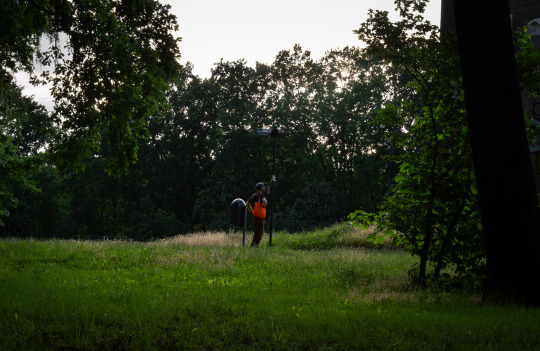
Into the green with a splash of color. 🌿🎒
#nikon#beginner photographer#original photographers#photographers on tumblr#photography#original photography blog#nature#berlin#naturephotography#trees#forest#naturecore#nature hikes#hikers#IntoTheWild#NatureExploration"#IntoTheTrees#NaturePhotography#QuietMoments#exploitation#explore
5 notes
·
View notes
Text

36 notes
·
View notes
Text

Nasugbu, Batangas
Jump-off point: Evercrest Golf Course, Nasugbu
LLA: 14.0408 N 120.8011 E 811 MASL
Days required / Hours to summit: 1 day / 2-4 hours
Features: Open trails, rolling slopes, scenic views of Batangas
Specs: Minor climb, Difficulty 4/9, Trail class 3 with 60-70 degrees assualt
Mt. Batulao's cool environment provides an enjoyable getaway from the city. On a clear day, it provides magnificent views of the terrain in Batangas and other adjacent provinces. The height of Mt. Batulao is 811 meters (2,660 feet) above sea level. It features established paths that are suitable for beginners and has a 4/9 difficulty rating. Its gorgeous rolling slopes and somewhat steep topography make it one of the coolest mountains to climb in Southern Luzon.
The name of Mount Batulao has a fascinating beginning. The word "yellow stone" is Batong Dilaw in Tagalog. According to legend, the mountain received its name because, on clear days, the early morning sun's rays would paint the slope yellow. Mt. Batulao's beauty throughout the year is more than enough to make it one of the most popular hiking destinations in the Southern Luzon region, even though this only occurs during the last week of December.
You will experience the same chill as Tagaytay visitors the moment you arrive at the Evercrest Golf Course, the jumpoff. And this temperature will follow you around, even in the typically dry and chilly months of January and February. On the other hand, due to the exposed aspect of its routes and its propensity for muddiness during the wet season (June to October), there are some days when Mt. Batulao can feel like a desert—extremely hot and humid. However, Mt. Batulao frequently receives gusts that make any trek, regardless of how hot or how cool, delightful.
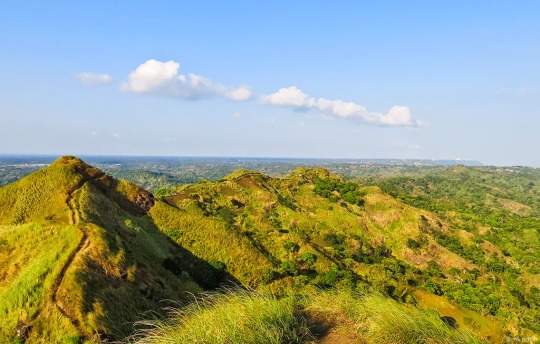
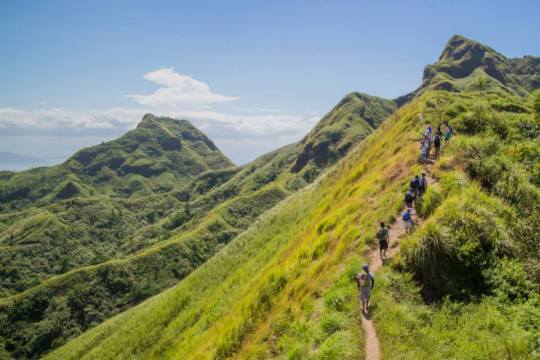

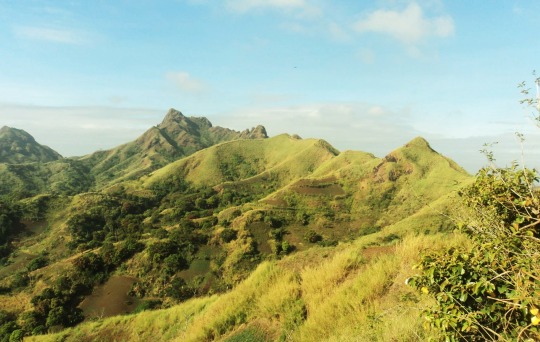
8 notes
·
View notes
Text
Annie's Canyon Trail
For my first post I will be talking about my most recent adventure in San Diego which consisted of taking a hike at Annie's Canyon Trail in Solana Beach. This trail was short but effective and consisted of two options to get to the top. There was both an easy version and a difficult version which both led to the same viewpoint at the top. The "difficult" pathway which I took takes you through the slot canyon. While I would not recommend this to anybody with claustrophobia as the opening was very tight, it was very achievable.
The total time inside the slot for me personally was about 5-7 minutes as there were also others completing the hike as well, but may take shorter or longer depending on how quickly you move. While in the slot you come across a bar ladder that you will need to climb to get to the end of the slot opening. Inside the slot you also see many markings along the walls, but it isn't advised to create any additional markings, there was also a small opening in the slot. This opening appears as a very small cave that you can step into while making your way through. Once at the top of the slot, there is a viewpoint that overlooks to the highway on one side and the ocean on the other. Coming back down from the slot I took what was considered the "easy" path. As someone who hasn't completed many hikes this was a good option as a beginner hike. There was the option to continue onto another path once completing the slot portion, but I opted to end after completing the slot.
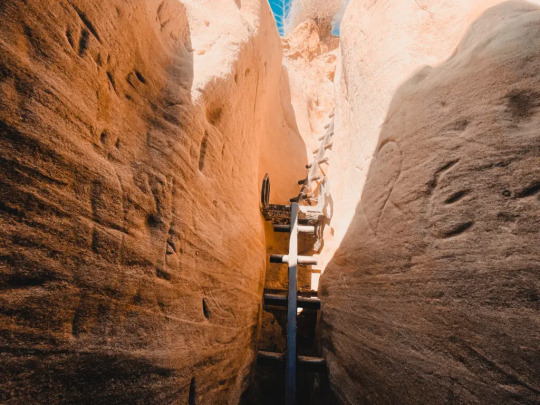
After this hike I decided to find a place to relax for the next couple of hours, so I took a short drive up to La Jolla shores beach. This was a great beach to check out as its in a great area and is a beautiful beach. I watched as people surfed and families walked along the beach enjoying their Friday afternoon. If you are in the area I suggest watching the sunset at this beach as well as taking some time to relax for a while, as the surrounding area is very calm unlike some other beaches in the area.
For my next "adventure" in the San Diego area I decided to hike a nearby trail at Mission Trails Regional Park with a friend. This hike will be a little more "intense" than the one at Annie's Canyon trail but is still considered an "easier" trail. I will talk more about this hike in my next post.
9 notes
·
View notes
Text
Mount Kessler Trails invite you to lose yourself in nature. Explore winding paths through lush forests, perfect for hiking, biking, and soaking up the Ozark beauty.
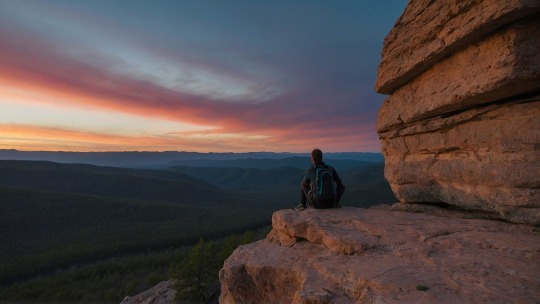
Whether you crave a gentle walk or a thrilling climb, there's a trail here waiting for you.
Ready to hit the trails? My latest blog post is your guide to Mount Kessler. Discover hidden gems, pick your ideal route, and dive into the park's fascinating history.
Get those hiking boots ready - adventure awaits, as it always is on Start Your Hike!
To see this blog post in more detail, you can visit this link on Mount Kessler Trails!
#hiking#hiking adventures#hikingforbeginners#hiking trail#nature hikes#travel#hiking for beginners#hiking trip#hiking trails
0 notes
Text
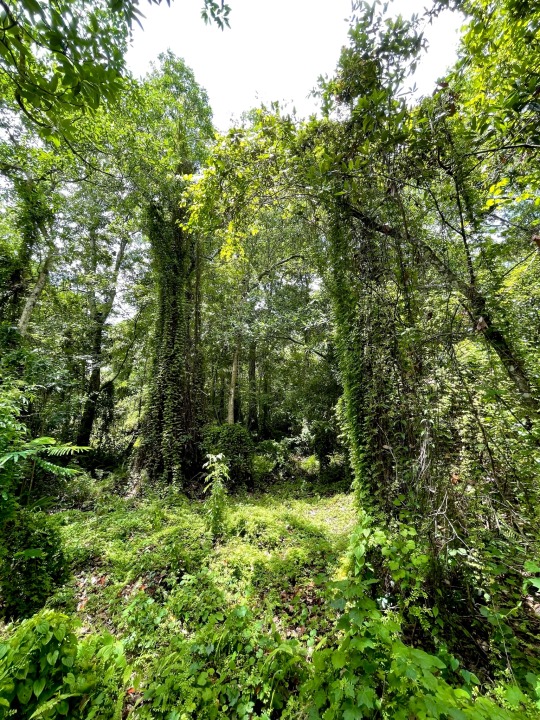
lush
#lush#green#greenery#nature#landscape#photographers on tumblr#cabgphoto#landscape photography#beautiful#adventure#trail#hike#forest#foliage#photography for beginners#original photographers#nature photography
36 notes
·
View notes
Text
So there’s a woc outdoors group for the pnw and I signed up for the backpacking trip and it’s a beginner one bc I haven’t done that before and I got in and I’m sooo excited that was one of my goals for my 30th birthday lmao
Also nervous bc it’s all strangers and guides and all that but at same time what an adventure haha
#a group of beginners make me less nervous bc I’m always self conscious about how slow I hike#I fractured an ankle a couple years ago and so I’m avoiding injuries and evan just zooms
3 notes
·
View notes
Text
Beginner Hikers: Trail Etiquette
@somesuchnonsense added some EXCELLENT info in the tags on my beginner gear post about Hiking Etiquette, and frankly, it deserves its own post:
While you might be going out hiking to get away from other people, odds are good you're still going to encounter a few other folks doing the same, and some basic politeness and understanding of trail etiquette can keep you from being that guy.
So!
How to Not Be An Asshole Hiker:
Acknowledge Other Hikers. You don't have to have a whole conversation -- most people don't want you to -- but making eye contact with a brief nod or 'hello' as you cross paths is considered polite.
Respect the Right of Way. While you're going one way on the trail, someone else may be coming the other way. If the trail is narrow, one of you is going to have to step to the side. The general rule is that hikers going uphill have the right of way, and hikers going downhill should yield. That being said, if you have the right of way but notice that you have a better spot to step off to the side of the trail safely than the other person or party, it's polite to do so. Also, if you are hiking solo and there's a large group coming through the other way, it's polite to let them pass since it's easier for one person to move aside than a whole troupe. It's also polite to acknowledge people going the same way as you at a slower pace that you may be passing, and give them a chance to step aside before you pass them.
Stay On The Trail. Apart from stepping aside to the edge of the trail to let others pass, you should stick to the blazed trail and avoid bushwhacking. This is important for your safety so you don't get lost, and also for the ecosystem -- you could be damaging protected plant life or increasing erosion by trying to make your own shortcut. (Reasonable excuses to leave the trail are if you need to relieve yourself, or if there is a tree down or rock slide across the trail that you need to circumvent for safety)
Leave No Trace. On the topic of not damaging the ecosystem -- If you're gonna have a picnic, bring a bag for your garbage (or any toilet paper if you had to use some), and be sure to clean up after yourself, and erase any signs you were there. Everyone else wants to enjoy the scenic beauty of nature too, so leave it as pristine as you found it. [Side note: Leave the rocks alone, do not stack them into cairns, but also do not mess with existing cairns by adding or removing rocks if you see any -- these are often built by trail maintainers as trail markers in places above tree line where blazes may be obscured by snow and are important to keep folks from getting lost]
No One Wants to Hear Your Music. So you have a cool little Bluetooth speaker so you can blast your favorite tunes with your friends? Cool! Keep it at home! If you want to listen to music when you hike, wear headphones. Don't make your noise everyone else's problem. Enjoy the sounds of nature, and respect that other hikers may be out here for the serenity of the wild, and not your spotify playlist.
Look Out For Other Hikers. If you see another hiker in distress, see if they need help. If there's a problem on the trail up ahead or conditions they should be aware of for safety, give other hikers a heads up. Step up to be a good samaritan where one is needed if you are able. Some of the kindest strangers I've had the honor of meeting, I've encountered on a trail. It can be a really wonderful community!!!
#lena hikes#hiking etiquette#this isn't getting into the winter hiking etiquette about snow pack and post holing and all that jazz#because frankly winter hiking is its own animal and I'm still learning a lot there#beginner hiking#thank you somesuchnonsense!
784 notes
·
View notes
Text

Can Beginners Trek to Everest Base Camp?
#everest#hiking#beginners#nepal#heavenhimalaya#explorenepal#landscapephotography#mounteverest#everestbasecamp
3 notes
·
View notes
Text
Tips for Beginners: How to Start Hiking
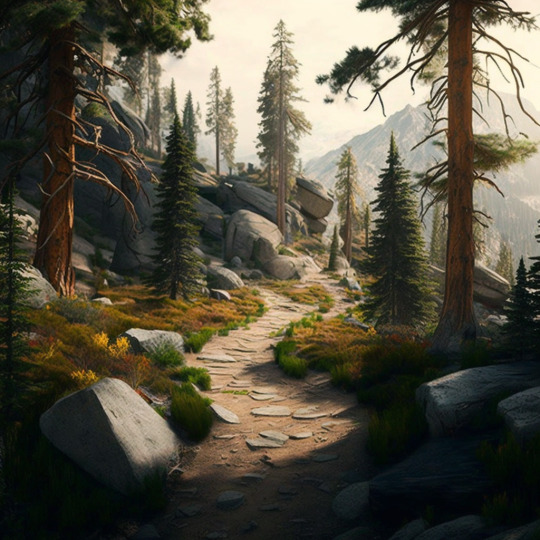
Hiking is a great way to enjoy the outdoors, get some exercise, and clear your mind. However, if you're new to hiking, it can be daunting to know where to start. Here are some tips for beginners to help you get started on your hiking journey.
Start small: Don't jump into a long, strenuous hike right away. Start with shorter hikes on easy trails to build up your endurance and confidence.
Choose the right trail: Make sure to choose a trail that's appropriate for your fitness level and experience. Research the trail beforehand to ensure you know what to expect in terms of difficulty, terrain, and elevation gain.
Wear appropriate gear: Wear comfortable, sturdy shoes with good traction and support, as well as breathable clothing appropriate for the weather. Don't forget to bring a hat, sunscreen, and bug spray.
Stay hydrated: Bring plenty of water and snacks to keep your energy levels up. It's important to stay hydrated, especially on longer hikes.
Pack the essentials: Bring a map, a compass, and a first-aid kit. It's always better to be over-prepared than under-prepared.
Hike with a friend: Hiking with a friend can make the experience more enjoyable and safer. Plus, it's always a good idea to have someone to rely on in case of an emergency.
Leave no trace: Respect the environment and wildlife by leaving no trace of your visit. Pack out all trash and avoid disturbing plants and animals.
By following these tips, you can start hiking with confidence and enjoy all that the great outdoors has to offer. Happy trails!
2 notes
·
View notes